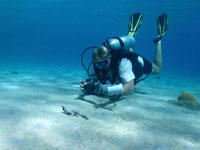Though declines in coral health have been documented worldwide, the effects of this decline on reef inhabitants are poorly studied. Studies monitoring fish abundances through coral declines are often inconclusive or contradictory in their results. This study uses fish assemblage data from REEF's database, as well as bleaching data compiled by ReefBase and reef health data collected by Reef Check, to correlate reef inhabitant abundance with bleaching events. Data are analyzed with respect to species, reef location, bleaching severity, and recovery time.
This study analyzed temporal trends of the yellow stingray in the Florida Keys National Marine Sanctuary (FKNMS) as recorded by trained volunteer divers using the Roving Diver Technique. Data were obtained from the REEF Fish Survey Project. A generalized linear model on presence-absence data was used to estimate the change in yellow stingray by year. Habitat type, bottom time, depth, site, water temperature, and Julian date were included in the model to standardize the data. The decline in sighting frequency has occurred in all habitat types, depths, sites, and regions of the FKNMS.
asdfasdfassdf alksdjfalksdjflaksjf
"Did you ever have a fish experience that both excited and sadden you?"
To those who are in the know, St Vincent is considered the critter capital of the Caribbean. To those who watch fish, it is known that the rare is commonplace and that the fishwatching is unlike any other location in the Caribbean. REEF’s data from the June Field Survey supports those claims. With a team of 13 divers, the REEF group recorded an astounding 243 species, more than 65 of which were unlisted “write-ins” on the survey forms.
WASH Nearshore Symposium

